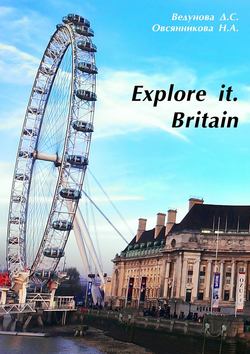Читать книгу Explore it. Britain - Д. С. Ведунова - Страница 4
Scotland
ОглавлениеScotland is famous for its cold, endless rain, a little gloomy beauty of picturesque plains, covered with heather uplands, old castles, known worldwide for its Loch Ness Monster, Scottish bagpipe and cloth.
As everyone knows, Scotland is a part of a modern Britain, at the same time it is a very special part of it, which occupies the north of the country and adjacent islands (more precisely, the 787 islands belonging to the group of the Hebrides, Orkney and Shetland), its area is about one-third the area of the UK (787.7 km2), and the population – about one-tenth (5.1 mln. people). Scotland is washed by the North Sea in the east and the Atlantic Ocean in the north- west. The main city is Edinburgh.
Official language is English. In the north of Scotland and the islands people speak Gaelic – Scots language of Celtic origin. Scotland has some autonomous rights – its legal and educational systems, banknotes are printed on special designs and they must be accepted in England. There is the Scottish Parliament in Edinburgh, but this prerogative was granted to Scotland only in 1999. Scotland has its own government. But the head of state for Scotland is the Queen Elizabeth. Patron Saint of Scotland is Andrew (St. Andrew), and St. Andrew’s Day is celebrated worldwide on the 30 of November.
National flag of Scotland is St. Andrew’s, a white cross on a blue background, has become a symbol of national independence. Biblical legend has it that St. Andrew was crucified by the Romans on a diagonal cross, because the cross on the flag of St. Andrew is located diagonally. St. Andrew’s flag appeared in Scotland in the XII century. The second national flag, also belonging to Scotland – Royal flag depicting the rampant lion (called “Lord of the lion”).
Scottish Highlands occupies the north and north-west; in the central plains they are located in the south. There are 26 rivers there, the largest three are: the Clyde, the Forth and the Tay, they provide supplies to Glasgow, Edinburgh and Dundee. Scotland is known for its lakes. The most famous is the Loch Ness.
History of Scotland.
Scotland was inhabited by the Picts and the Gauls, in the V – VI centuries. The Scots came here from Ireland and gave the name to this place (the country of the Scots). After several centuries of struggle against the Picts in 843, Scots were able to crown their king Kenneth Mc Alpina. In the XI century there was a social, political and religious revolution – the Scottish King Malcolm Canmore married to the English princess Margaret. He wanted the country to have the English language and traditions. At that time, strong trade ties between the two countries were established. By the XI century Scottish kingdom, uniting the territory of several powerful clans was formed. After the Norman conquest of England (1066) Scotland culture has been influenced by French culture.
Scotland flourished before the XIV century, until the English King Edward I decided to subordinate it to the English crown. Over the next three centuries Scotland remained independent, but poor country. The struggle against British rule led by Robert the Bruce, the Scottish hero, who was crowned in Skoukone and defeated the English at Bannockburn. After the battle, Britain recognized the independence of Scotland. The dynasty of the Stuarts started in 1371, in Scotland.
In 1603, England and Scotland were united, but not as a result of the war, but with the help of those who wanted to see England Catholic again. So the Scottish King James I, the son of Mary Stuart, became a king of England and Scotland.
The Industrial Revolution contributed to the development of cotton production and shipbuilding, as well as trade prosperity. However, it followed the crisis of overpopulation and famine caused many Scots to leave their country. Scots immigrated to North America, New Zealand and Australia.
The main industries of Scotland are banking, finance, transport equipment, steel production, oil and gas, production and sale of whiskey, and tourism.
Scottish National clothes. The world-famous Scottish kilt has been worn by mountaineers for many centuries. Kilt is men’s clothing. Women wore a national dress which is a pleated skirt, which has a strictly defined length – no less and no more than mid-knee.
Scotland Cities. Edinburgh became the capital of Scotland, only in the XII century. Prior to this, the Scottish kings were crowned at Scone first, then in Dunfermline. Edinburgh is located in the extraordinarily picturesque location between the sea and the hills. One of the main attractions is the ancient castle made of basalt. There is the oldest building in Edinburgh – the chapel of Queen Margaret of Scotland in the area of the castle. The Scottish crown, scepter and sword of state are kept here. They are considered to be one of the most ancient royal regalia in Europe. The castle is very popular.
The Royal Palace of Holyroodhouse is the official residence of the Queen during her stay in Scotland. The palace was built on the orders of King James IV in 1498. Mary of Scotland lived here. For a long time, the palace was abandoned. King George IV brought it back to life. A fine collection of French and Flemish tapestries is assembled here. The city has many areas where people can relax, visit the many pubs and restaurants.
Questions on the basis of the material studied:
1. Who is the head of state in Scotland?
2. How long has Scotland got its Parliament?
